
Garin lo Brun or le Brun [1] (Latin : Garis Bruni; died 1156/1162) was an early Auvergnat troubadour.

Garin lo Brun or le Brun [1] (Latin : Garis Bruni; died 1156/1162) was an early Auvergnat troubadour.
Garin lived in the Diocese of Le Puy-en-Velay, where his family owned castles. He was himself lord of Châteauneuf-de-Randon in the Gévaudan and a vassal of Ermengarde of Narbonne and of Eleanor of Aquitaine. [2] [3] His origins were either in the Diocese of Mende [3] or in Randon. [4] If he was of Randon, then his father was Garin (Guérin) de Randon, a vassal of Raymond Berengar III, Count of Barcelona, of whom Guérin and his brother Odilon held the castle of Randon. [5] This is likely, as a Garin paid homage to the count of Barcelona for this castle in 1150. In 1162, Garin lo Brun appears to have died, as in that year his brother William (Guillaume), called Randon protecteur des troubadours ("Randon, Protector of Troubadours"), arranged a requiem mass for him and granted Grosvialla (Groviala) to the Knights Templar for the rest of his soul. [5]
Garin composed mostly tensos , but only one of these has survived and is an imaginary dialogue between Mezura (moderation) and Leujaria (lightness), that is, both sides of the debate are written by Garin. For Lightness, the true wisdom in love is folly: a man must get on, lose no chances, and show boldness to obtain the favour of ladies of the highest possible rank. Moderation, on the other hand, advises self-restraint in love, treading softly without showing impatience. Moderation's advice to women is not to give all they have suddenly, leaving nothing to offer. [5] [6] This tenso was dedicated to one Eblon de Saignes. [4]
The medievalist Mark Johnston notes that Garin's work is similar to that of another 12th-century troubadour poet, Arnaut Guilhem de Marsan. [7]
The author of Garin's vida (biography) comments that "he went to the trouble of telling the ladies how they should behave themselves." [8]
Garin wrote the earliest known example of an ensenhamen or didactic (teaching) poem to have survived, which has the title El termini d'estiu. [9] This is written in isometric rhymed hexameter and has been dated to 1155. [2] Perhaps the earliest known text is contained in the Pierpont Morgan Library's MS 819, an illuminated manuscript of the 13th century, in which Garin's poem is contained together with another similar didactic work by Arnaut de Mareuil, in the first fifty-two folios. [10]
Garin's work has over a hundred verses on the beauty of nature and the sorry state of contemporary mores, but its main theme is the courtly behaviour of women. It is therefore sometimes called Ensenhamen de la donzela ("Ensenhamen of the girl") or L'ensegnamen alla dama ("The ensenhamen to woman"). It is part of the medieval "conduct literature" which urges women to adapt themselves to their husbands, to be merry or sad as their men are merry or sad. [11] Garin counsels also that women should sing and recite poetry for their guests. [12]
An excerpt from the Ensenhamen says:
|
Another passage of the Ensenhamen which is sometimes quoted advises women to "welcome entertainers and poets who chatter of love and sing verses and melodies. At least, show them a good face, for if you give them nothing, they will make your name known far and wide." [14]
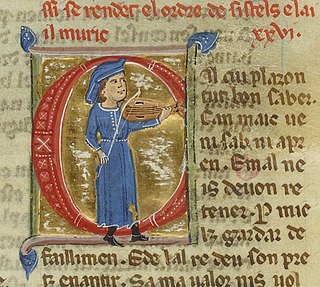
A troubadour was a composer and performer of Old Occitan lyric poetry during the High Middle Ages (1100–1350). Since the word troubadour is etymologically masculine, a female equivalent is usually called a trobairitz.

Languedoc-Roussillon is a former administrative region of France. On 1 January 2016, it joined with the region of Midi-Pyrénées to become Occitania. It comprised five departments, and bordered the other French regions of Provence-Alpes-Côte d'Azur, Rhône-Alpes, Auvergne, Midi-Pyrénées towards the north, and Spain, Andorra and the Mediterranean Sea towards the south. It was the southernmost region of mainland France.

Arnaut Daniel was an Occitan troubadour of the 12th century, praised by Dante as "the best smith" and called a "grand master of love" by Petrarch. In the 20th century he was lauded by Ezra Pound in The Spirit of Romance (1910) as the greatest poet to have ever lived.
Occitan literature is a body of texts written in Occitan, mostly in the south of France. It was the first literature in a Romance language and inspired the rise of vernacular literature throughout medieval Europe. Occitan literature's Golden Age was in the 12th century, when a rich and complex body of lyrical poetry was produced by troubadours writing in Old Occitan, which still survives to this day. Although Catalan is considered by some a variety of Occitan, this article will not deal with Catalan literature, which started diverging from its Southern French counterpart in the late 13th century.
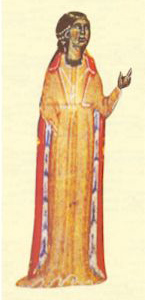
The trobairitz were Occitan female troubadours of the 12th and 13th centuries, active from around 1170 to approximately 1260. Trobairitz is both singular and plural.

The Comtessa de Dia, possibly named Beatritz or Isoarda, was a trobairitz.
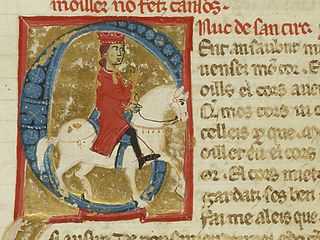
Uc de Saint Circ or Hugues (Hugh) de Saint Circq was a troubadour from Quercy. Uc is perhaps most significant to modern historians as the probable author of several vidas and razos of other troubadours, though only one of Bernart de Ventadorn exists under his name. Forty-four of his songs, including fifteen cansos and only three canso melodies, have survived, along with a didactic manual entitled Ensenhamen d'onor. According to William E. Burgwinkle, as "poet, biographer, literary historian, and mythographer, Uc must be accorded his rightful place as the 'inventor' (trobador) of 'troubadour poetry' and the idealogical trappings with which it came to be associated."

Daude, Deude, Daurde, or Daudé de Pradas was a troubadour from Prades-Salars in the Rouergue not far from Rodez. He lived to an old age and left behind seventeen to nineteen cansos, including twelve on courtly love, three about sexual conquest, one tenso, one planh, and a religious song. Only one melody of his entire oeuvre has survived.

Giraut or Guiraut de Calanso or Calanson was a Gascon troubadour in the Occitan language. Of his lyric works that remain five are cansos, two descorts, a congé, a planh, and a vers. He also wrote a mock ensenhamen entitled Fadet juglar.

Margeride is a mountainous region of France, situated in the Massif Central, inside the départements of Cantal, Haute-Loire and Lozère.
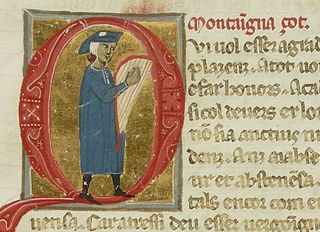
Guilhem de Montanhagol was a Provençal troubadour, most likely active in Toulouse, but known in the courts of Provence, Toulouse, Castile, and Aragon. Guilhem left behind seven cansos and six sirventes. He also left behind one tenso with Sordello and his total surviving output comes to fourteen pieces.

Iseut de Capio was a noblewoman and trobairitz from Gévaudan. She was a neighbour and contemporary of the trobairitz Almucs de Castelnau, with whom she shared the composition of a tenso. It is her only surviving piece of work.
Arnaut Guilhemde Marsan was a Landais nobleman and troubadour. He was descended from a cadet branch of the viscounts of Marsan and was himself lord of Roquefort and Montgaillard and co-lord of Marsan.
An ensenhamen was an Old Occitan didactic poem associated with the troubadours. As a genre of Occitan literature, its limits have been open to debate since it was first defined in the 19th century. The word ensenhamen has many variations in old Occitan: essenhamen, ensegnamen, enseinhamen, and enseignmen.

Raimon de Cornet was a fourteenth-century Toulousain priest, friar, grammarian, poet, and troubadour. He was a prolific author of verse; more than forty of his poems survive, most in Occitan but two in Latin. He also wrote letters, a didactic poem, a grammar, and some treatises on computation. He was the "last of the troubadours" and represented l'esprit le plus brillant of the "Toulousain School". He appears in contemporary documents with the titles En and Frare.
Nationality words link to articles with information on the nation's poetry or literature.

Peire de Barjac was a Languedocian troubadour who flourished in the first half of the thirteenth century. He was a descendant of the troubadours Guillem de Randon and Garin lo Brun.
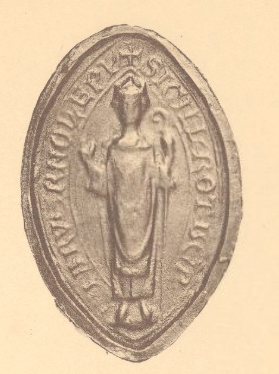
Robert of Auvergne, also called Robert de la Tour, was a French nobleman, prelate and poet from the Auvergne. He served as bishop of Clermont from 1195 until 1227 and thereafter as archbishop of Lyon until his death. He was also a troubadour, composing poetry in Occitan.
Lisa de Londres was a trobairitz, a female composer in Old Occitan. Her work is known only from three lines quoted in Italian translation in the Reggimento e costumi di donna of Francesco da Barberino, who also mentions her in his Documenti d'amore. The three lines are: